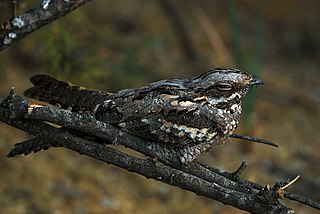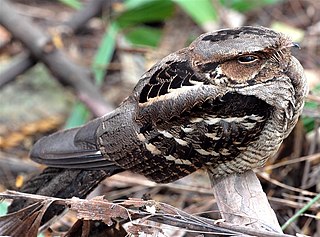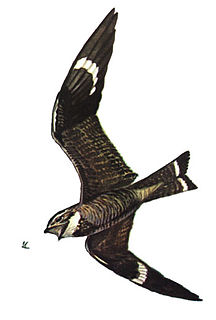
Nightjars are medium-sized nocturnal or crepuscular birds in the subfamily Caprimulginae and in the family Caprimulgidae, characterised by long wings, short legs and very short bills. They are sometimes called goatsuckers, due to the ancient folk tale that they sucked the milk from goats, or bugeaters, due to their insectivore diet. Some New World species are called nighthawks. The English word 'nightjar' originally referred to the European nightjar.

The European nightjar, common goatsucker, Eurasian nightjar or just nightjar, is a crepuscular and nocturnal bird in the nightjar family that breeds across most of Europe and temperate Asia. The Latin generic name refers to the old myth that the nocturnal nightjar suckled goats, causing them to cease to give milk. The six subspecies differ clinally, the birds becoming smaller and paler towards the east of the range. All populations are migratory, wintering in sub-Saharan Africa. Their densely patterned grey and brown plumage makes individuals difficult to see in the daytime when they rest on the ground or perch motionless along a branch, although the male shows white patches in the wings and tail as he flies at night.

The Caprimulgiformes is an order of birds that includes a number of birds with global distribution. They are generally insectivorous and nocturnal. The order gets its name from the Latin for "goat-milker", an old name based on an erroneous view of the European nightjar's feeding habits.

The nighthawk is a nocturnal bird of the subfamily Chordeilinae, within the nightjar family, Caprimulgidae, native to the western hemisphere. The term "nighthawk", first recorded in the King James Version of 1611, was originally a local name in England for the European nightjar. Its use in the Americas refers to members of the genus Chordeiles and related genera was first recorded in 1778.

Owlet-nightjars are small crepuscular birds related to the nightjars and frogmouths. Most are native to New Guinea, but some species extend to Australia, the Moluccas, and New Caledonia. A flightless species from New Zealand is extinct. There is a single monotypic family Aegothelidae with the genus Aegotheles.

The eastern whip-poor-will is a medium-sized (22–27 cm) nightjar from North America. The whip-poor-will is commonly heard within its range, but less often seen because of its camouflage. It is named onomatopoeically after its song.

The Puerto Rican nightjar or Puerto Rican Whip-poor-will is a bird in the nightjar family found in the coastal dry scrub forests in localized areas of southwestern Puerto Rico. It was described in 1916 from bones found in a cave in north central Puerto Rico and a single skin specimen from 1888, and was considered extinct until observed in the wild in 1961. The current population is estimated as 1,400-2,000 mature birds. The species is currently classified as Endangered due to pressures from habitat loss.

The chuck-will's-widow is a nocturnal bird of the nightjar family Caprimulgidae. It is found in the southeastern United States near swamps, rocky uplands, and pine woods. It migrates to the West Indies, Central America, and northwestern South America. This bird is generally confused with the better-known whippoorwill, because of their similar calls and unusual names. Though rather closely related, they are two distinct species.

The buff-collared nightjar is a small nightjar. Adults are dark with brown, grey, black and white patterning on the upperparts and breast. The tail is dark brown, with darker finely barred markings throughout. The male has large white outer tail tips on the 3 outermost tail feathers. The female has buffy tail tips. These are most distinguishing characteristic to distinguish its identity from its closest relative the Whip-poor-will from where the bird gets its name. It shows a prominent buff-colored collar around its neck and nape. Its song is also very different. It sounds like an accelerating cuk, cuk, cuk, cuk, cuk, cukacheea.

The Caprimulginae or typical nightjars are a nocturnal bird subfamily within the nightjar family, Caprimulgidae. They are medium-size with long wings, short legs, and very short bills. They usually nest on the ground. They feed on flying insects.
The Yucatan nightjar is a species of nightjar in the family Caprimulgidae, found in Belize, Guatemala, Mexico, Nicaragua, and possibly Honduras. Its natural habitat is subtropical or tropical dry forests.

The Cuban nightjar, is a species of nightjar in the family Caprimulgidae. It is commonly found in Cuba, Cayo Coco and the Isle of Pines. Its natural habitats are subtropical or tropical moist lowland forests and subtropical or tropical moist montane forests.
The Hispaniola nightjar, also known as the Hispaniolan nightjar, was previously considered a subspecies of the Greater Antillean nightjar. The IOC now consider it to be a distinct species. It is found in Haiti and the Dominican Republic.

The rufous nightjar is a species of nightjar in the family Caprimulgidae.

The tawny-collared nightjar is a species of nightjar in the family Caprimulgidae. It is endemic to Mexico. Its natural habitat is subtropical or tropical dry forests.

The dusky nightjar is a species of nightjar in the family Caprimulgidae. It is found in Costa Rica and western Panama. Its natural habitats are subtropical or tropical moist montane forests and heavily degraded former forest.

The silky-tailed nightjar is a species of nightjar in the family Caprimulgidae. It is found in Argentina, Bolivia, Brazil, Paraguay, and Peru. Its natural habitat is subtropical or tropical moist lowland forests.

The Mexican whip-poor-will,, is a medium-sized (22–27 cm) nightjar from the southwestern United States and Mexico. The whip-poor-will is more often heard within its range, but less often seen. It is named onomatopoeically after its song.

Antrostomus is a genus of nightjars formerly included in the genus Caprimulgus. They are medium-sized nocturnal birds with long pointed wings, short legs and short bills.














